 W
WRoland Corporation is a Japanese manufacturer of electronic musical instruments, electronic equipment and software. It was founded by Ikutaro Kakehashi in Osaka on April 18, 1972. In 2005, Roland's headquarters relocated to Hamamatsu in Shizuoka Prefecture. It has factories in Malaysia, Taiwan, Japan, and the USA. As of March 31, 2010, it employed 2,699 people. In 2014, Roland was subject to a management buyout by Roland's CEO Junichi Miki, supported by Taiyo Pacific Partners.
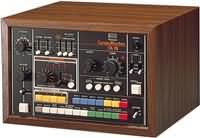 W
WThe Roland CompuRhythm CR-78 is a drum machine launched in 1978. Although primitive by later standards, the CR-78 represented an important advance in drum machine technology at the time, in particular by allowing users to program and store their own drum patterns.
 W
WThe Roland D-50 is a synthesizer produced by Roland and released in April 1987. Its features include subtractive synthesis, on-board effects, a joystick for data manipulation, and an analogue synthesis-styled layout design. The external Roland PG-1000 (1987-1990) programmer could also be attached to the D-50 for more complex manipulation of its sounds. It was also produced in a rack-mount variant design, the D-550 (1987-1990), with almost 450 user-adjustable parameters.
 W
WThe Roland E-20 is a keyboard instrument introduced by Roland in 1988.
 W
WThe Roland JD-800 is a digital synthesizer that was manufactured between 1991 and 1996. It features many knobs and sliders for patch editing and performance control — features that some manufacturers, including Roland, had been omitting in the name of streamlining since the inception of the Yamaha DX7. The JD-800 thus became very popular with musicians who wished to take a hands-on approach to patch programming. The introduction in the manual states that Roland's intention with the JD-800 was to "return to the roots of synthesis".
 W
WThe Roland JP-8000 is an analog modeling synthesizer released by the Roland Corporation in 1996.
 W
WRoland Juno-G is a music workstation/synth introduced in 2006 by Roland Corporation. It is based on the Fantom-X series, having a vintage design that resembles the first Juno synthesizers, such as the Juno-106. The Juno-G's main competitors in the approximate price range, with similar features, when first released, were the Korg Triton Le/TR and Yamaha MO6 workstation synthesizers.
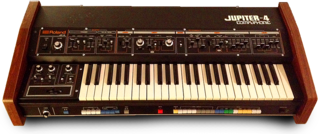 W
WThe Roland Jupiter-4 (JP-4) was an analog synthesizer manufactured by the Roland Corporation between 1978 and 1981. It was notable as the company's first self-contained polyphonic synthesizer, and for containing digital control of analog circuits, allowing for such features as programmable memories and voice assignment modes.
 W
WThe Jupiter-8, or JP-8, is an eight-voice polyphonic analog subtractive synthesizer introduced by Roland Corporation in early 1981.
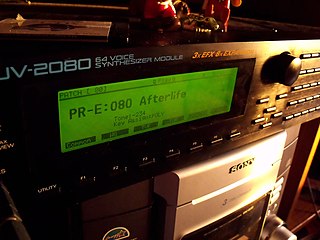 W
WThe Roland JV-2080 is a rack-mount expandable MIDI sound module, and an improved version of the Roland JV-1080. Produced by the Roland Corporation, released in 1996 and built on a sample-based synthesis architecture, the JV-2080 provides a library of on-board sample material and a semi-modular synthesis engine.
 W
WThe Roland JX-3P is a synthesizer produced by Roland Corporation of Japan from 1983-1985. The "3P" in its name refers to "Programmable Preset Polyphonic". It is notable as one of the company's first synthesizers to incorporate a MIDI interface.
 W
WRoland JX-8P is a 61-key, velocity- and aftertouch-sensitive, six-note polyphonic, fully analog synthesizer released by Roland in 1985. In a time of rising popularity of digital frequency modulation synthesizers, such as Yamaha DX7, JX-8P was marketed as the best of both worlds: while it was possible to create classic analog synth sounds, several new modulation parameters and redesigned hardware enabled it to produce certain types of sounds associated with FM synthesis, such as metallic percussive sounds. Likewise, traditional hands-on controls were replaced with a DX-style interface with membrane buttons and one "edit" slider.
 W
WThe Roland MC-4 MicroComposer was an early microprocessor-based music sequencer released by Roland Corporation. It could be programmed using the ten key numeric keyboard or a synthesizer keyboard using the keyboard's control voltage and gate outputs. It was released in 1981 with a list price of US$3,295 and was the successor to the MC-8, which in 1977 was the first microprocessor-based digital sequencer. Like its predecessor, the MC-4 is a polyphonic CV/Gate sequencer.
 W
WThe Roland MC-8 MicroComposer by the Roland Corporation was introduced in early 1977 at a list price of US$4,795. It was one of the earliest stand-alone microprocessor-driven CV/Gate music sequencers, following EMS Sequencer 256 in 1971 and New England Digital's ABLE computer (microprocessor) in 1975. Roland called the MC-8 a "computer music composer" and it was considered revolutionary at the time, introducing features such as a keypad to enter note information and 16 kilobytes of random access memory which allowed a maximum sequence length of 5200 notes, a huge step forward from the 8-16 step sequencers at the time. It also allowed the user to allocate multiple pitch CVs to a single Gate channel, creating polyphonic parts within the overall sequence. Due to the high price, only 200 units were sold worldwide, but it represented a huge leap forward in music technology.
 W
WThe Roland MC-09 "PhraseLab" is a Roland synthesizer, described as a Roland TB-303 emulator featuring an effects processor and a 4-part phrase sampler.
 W
WThe Roland MC-202 (MicroComposer) is a monophonic analog synthesizer and music sequencer released by Roland in 1983. It was the first groovebox. Its synth is similar to the TB-303 bass synth and the SH-101 synthesizer, featuring one voltage-controlled oscillator with simultaneous saw and square/pulse-width waveforms. It is a successor to the Microcomposer family of sequencers, including the MC-8 and MC-4. The unit is portable and can be operated from batteries or an external power supply.
 W
WThe Roland MC-303 is the first of a series of musical instruments known as a Groovebox. It combines a simple sound module with a sequencer to record and store notation, along with controls aimed at encouraging the musician to improvise the music while it is playing. Despite the number in its name and the attention it received at its launch, the MC-303 has more in common with other MC prefixed synthesizers, which contain built-in sequencers, than it does with the famous Roland TB-303. As the first Groovebox, the MC-303 was the first in a line of inexpensive products specifically targeted towards house DJs and amateur home musicians rather than professional producers. It was superseded by the Roland MC-505. It is the predecessor to the Roland JX-305, Roland D2, Roland MC-307, Roland EG-101, Roland MC-09, Roland MC-909, Roland MC-808, and most recently the Roland MC-707 in 2019, along with its more portable sibling, the Roland MC-101.
 W
WThe Roland MC-505 is a groovebox conceived in 1998 as a combination of a MIDI controller, a music sequencer , a drum machine, and a desktop synthesizer with many synthesis features: arpeggiator, oscillators, and voltage-controlled filter, control of attack, decay, sustain and release, diferents envelopes and 2 Lfo. It was released as the successor to the Roland MC-303 and is a compact version of the Roland JX-305 Groovesynth without the full set of 61 keys. It is also the predecessor to the Roland D2, Roland MC-307, Roland MC-909 and the Roland MC-808.
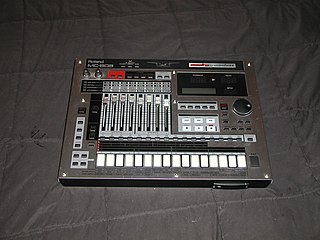 W
WThe Roland MC-808 was a groovebox, announced at the Winter NAMM in 2006. It is the successor to the late Roland MC-303, Roland MC-307, Roland MC-505 and Roland MC-909.
 W
WThe discontinued Roland MC-909 Sampling Groovebox combines the features of a synthesizer, sequencer, and sampler, with extensive hands-on control of both the sound engine and the sequencing flow. It was intended primarily for live performance of pre-programmed patterns consisting of up to 16 tracks of MIDI data. It was released by Roland Corporation on October 8, 2002. This product was announced at the AES Fall Convention in 2002. It is the direct successor to the Roland MC-505 and is the predecessor to the Roland MC-808. Which eventually ended the "Groovebox by year 2010" line of products by Roland which began in the year 1996 with the Original Roland MC-303 groovebox. The Roland Groovebox began again resurgence in the year 2019 with a two new modern & redesign Roland MC-707 GROOVEBOX/Roland MC-101 GROOVEBOX. The Roland MC-909 was developed from the blueprint of Roland's own "Roland Fantom-S Workstation & Roland Fantom-X Workstation" and uses the same structure and operating system, with some differences regarding the Patterns section, not implemented in the Roland Fantom S/X6/X7/X8 Workstation.
 W
WThe Roland MT-32 Multi-Timbre Sound Module is a MIDI synthesizer module first released in 1987 by Roland Corporation. It was originally marketed to amateur musicians as a budget external synthesizer with an original list price of $695. However, it became more famous along with its compatible modules as an early de facto standard in computer music. Since it was made prior to the release of the General MIDI standard, it uses its own proprietary format for MIDI file playback.
 W
WThe R-8 Human Rhythm Composer is an electronic drum machine introduced in 1989 by Roland Corporation, using PCM voices. The R-8 features velocity- and pressure-sensitive trigger pads, and the ability to create loops of beats. The device has eight individual outputs, 12-voice polyphony, and four-part multitimbral MIDI.
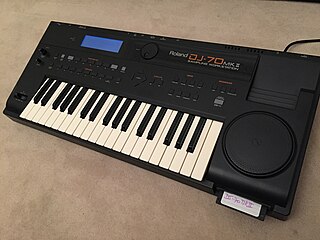 W
WThe Roland DJ-70 is a 16-bit linear A/D Conversion & 20-bit linear D/A Conversion sampling workstation and was released in 1992 by Roland Italy.
 W
WThe Roland JD-XA is a hybrid analog and digital synthesizer that was released in 2015, it is Roland's first analog polyphonic synthesizer since 1986. The instrument is encased by a shiny black front panel covered with knobs and sliders reminiscent of the Roland JD-800. The JD-XA comprises a 4 voice analog engine and a 64 voice digital engine, which can be used interactively or independently, thus providing a flexible platform for sound design.
 W
WThe Roland S-50 is a 61-key 12-bit sampler keyboard produced by the Roland Corporation in 1986. It featured a 3.5-inch DSDD floppy disk drive and had external CRT monitor support to facilitate editing of samples. It could hold up to 32 samples. A rack-mounted version was also available, which featured expanded memory.
 W
WRoland/Edirol Sound Canvas lineup is a series of General MIDI (GM) based pulse-code modulation (PCM) sound modules and sound cards, primarily intended for computer music usage, created by Japanese manufacturer Roland Corporation. Some models include a serial or USB connection, to a personal computer.
 W
WThe Roland SC-7 General MIDI Sound Module is a stand-alone MIDI synthesizer module by Roland Corporation. It was released in 1992. It supports the General MIDI System and can also be used as a MIDI interface for a computer. The Roland SC-7 provides the basic (capital) Roland Sound Canvas sounds in a compact design for stand-alone, IBM PC/AT or Apple Macintosh computer use.
 W
WThe SH-3A is a monophonic analog synthesizer that was manufactured by Roland from 1975 to 1981. It is unique in that it is capable of both the usual subtractive synthesis and also the less common additive synthesis, offering mixable waveforms at different footages. Two LFOs and a unique sample-and-hold section provided capabilities not found in competing self-contained synthesizers of the time. The SH-3A was Roland's first non-preset based synth. The predecessor, the Roland SH-1000, could also do this but didn't offer as much control as on the SH-3A. The rhythmic pulsing in the Blondie song "Heart of Glass" is an example of its sound.
 W
WThe Roland SH-101 is an analog synthesizer manufactured by the Roland Corporation between 1982 and 1986. Though it was something of a commercial failure during the time of its manufacture, it later became a staple of electronic music in the 1990s, particularly house music.
 W
WThe Roland SH-1000, introduced in 1973, was the first compact synthesizer produced in Japan, and the first synthesizer produced by Roland. It resembles a home organ more than a commercial synth, with coloured tabs labelled with descriptions of its presets and of the "footage" of the divide-down oscillator system used in its manually editable synthesizer section. It produced electronic sounds that many professional musicians sought after whilst being easier to obtain and transport than its Western equivalents.
 W
WThe Boss Dr. Sample SP-303 is a discontinued digital sampler from Boss, successor of the Boss SP-202 Dr. Sample. The SP-303 was revamped and redesigned in 2005, and released as the SP-404, by Roland Corporation.
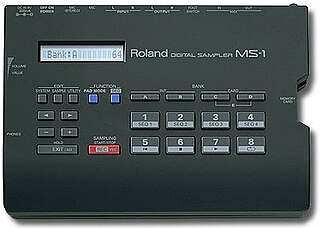 W
WThe Roland MS-1 Digital Sampler was a compact, 16-bit digital audio phrase sampler produced by Roland in 1994 as a straightforward, inexpensive, entry-level sampler. In the year of 1998, the sampler was succeeded by the Boss SP-202 sampler.
 W
WThe Roland SP-404 Sampling Workstation is a discontinued sampler made by Roland Corporation. Released in 2005, it is part of the SP family and successor to where Boss Corporation’s SP-505 sampler left off. The sampler was succeeded by the SP-555 in 2008, but was later given its own upgrade as the Roland SP-404SX Linear Wave Sampler in 2009. Another upgrade, the Roland SP-404A Linear Wave Sampler was released in 2017. A third upgrade, the SP-404MKII was released in 2021. The Roland SP-404 has played a huge role in influencing the sound of popular music genre Lo-Fi Beats.
 W
WThe SRX are a series of expansion boards produced by Roland Corporation. First introduced in 2000, they are small boards of electronic circuitry with 64MB ROMs containing patches (timbres) and rhythm sets. They are used to expand certain models of Roland synthesizers, music workstations, keyboards, and sound modules.
 W
WThe Roland System 700 was a professional monophonic modular synthesizer for electronic music manufactured by the Roland Corporation and released in 1976 and was followed by the Roland System-100M in 1978.
 W
WThe Roland System 100 was an analog semi-modular synthesizer manufactured by Japan's Roland Corporation, released in 1975 and manufactured until 1979. It consisted of the following products:
 W
WThe Roland System-100M was a modular analog synthesizer manufactured by the Roland Corporation in the late 1970s and early 1980s. It was the successor of the Roland System-100, a semi-modular keyboard.
 W
WThe Roland TB-303 Bass Line is a bass synthesizer released by Roland Corporation in 1981. Designed to simulate bass guitars, it was a commercial failure and was discontinued in 1984. However, cheap second-hand units were adopted by electronic musicians, and its "squelching" or "chirping" sound became a foundation of electronic dance music genres such as acid house, Chicago house and techno. It has inspired numerous clones.
 W
WThe Roland TR-505 Rhythm Composer was released by Roland, in 1986. It is a drum machine and MIDI sequencer from the same family as the Roland TR-909, TR-808, TR-707, Tr-626 and TR-606. The drum kit includes basic rock drum sounds similar to those of the TR-707, plus a complement of Latin-style drum sounds similar to those of the TR-727
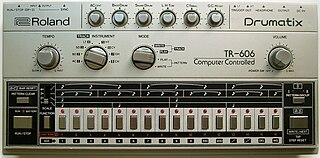 W
WThe Roland TR-606 Drumatix is a drum machine built by the Roland Corporation from 1981 to 1984. It was originally designed to be used with the Roland TB-303, a monophonic analog bass synthesizer, to provide a simple drum and bass accompaniment to guitarists without backing bands.
 W
WThe Roland TR-707 Rhythm Composer is a drum machine released by the Roland Corporation in 1985.
 W
WThe Roland TR-808 Rhythm Composer, commonly known as the 808, is a drum machine manufactured by the Roland Corporation between 1980 and 1983. It was one of the first drum machines to allow users to program rhythms instead of using preset patterns. Unlike its nearest competitor at the time, the more expensive Linn LM-1, the 808 generates sounds using analog synthesis rather than by playing samples.
 W
WThe Roland TR-909 Rhythm Composer is a drum machine introduced by the Roland Corporation in 1983. It succeeded the TR-808, and was the first Roland drum machine to use samples for some sounds. It was also the first Roland drum machine with MIDI functionality, allowing it to synchronize with other devices. Though it was a commercial failure, the 909 became influential in the development of electronic dance music genres such as techno, house and acid.
 W
WThe Roland U-20 is a PCM-sample synthesizer, released by Roland in 1988.
 W
WThe Roland VK-7 is an electronic keyboard introduced in 1997 which simulates the sound of an electromechanical Hammond organ. Like other electronic musical instruments that emulate the sound of the electromechanical tonewheel-based organs formerly manufactured by Hammond, the VK-7 is referred to as a clonewheel organ. Currently it is replaced by the VK-8 and the VK-88.
 W
WThe Roland VP-330 is a paraphonic ten band vocoder and string machine manufactured by Roland Corporation from 1979 to 1980. While there are several string machines and vocoders, a single device combining the two is rare, despite the advantage of paraphonic vocoding, and the VP-330's synthetic choir sounds are unique. Despite the VP-330's electronic string and choir sounds being less realistic than those of the tape-based Mellotron, touring musicians used it as a lighter and more robust alternative.
 W
WThe Roland XP-50 is a music workstation that combines the synthesizer engine of Roland's JV-1080 sound module with the sequencing capabilities of their MRC-Pro sequencer and a 61-note keyboard. First released in 1995, the XP-50 and the Roland XP-10 were the first two Roland XP-series products, later joined by the XP-80 and XP-30.
 W
WThe Roland XP-30 is a 61-key, 64-voice expandable synthesizer. Released in 1999, it was produced until 2002. Based on the acclaimed mid-90s JV sound engine built around a 32-bit RISC processor, it is considered to be the best value-for-money of all of the Roland JV and XP series synthesizers.
 W
WThe Roland XP-80 is a music workstation that uses digital PCM subtractive synthesis and combines an updated version of the JV-1080 synthesizer engine with the sequencer capabilities of the Roland MRC-Pro sequencer. The XP-80 was introduced in 1996 and is now discontinued.